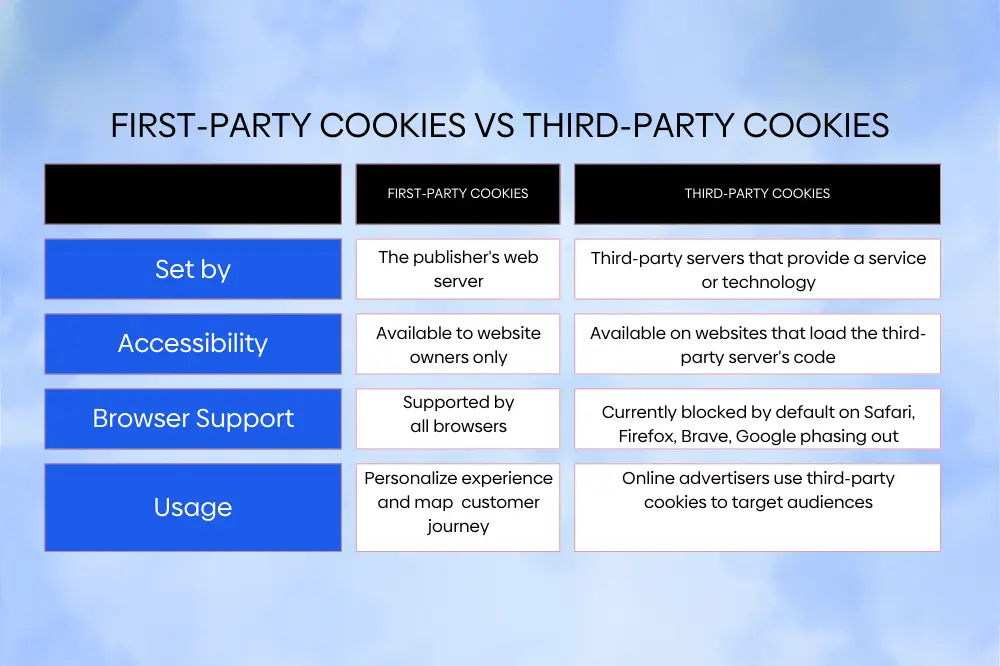A cookie-less world has been looming for so long that the demise of third-party cookies has begun to seem exaggerated. But no longer. With third-party cookies going away forever, the time has come to say goodbye.
In the beginning, cookies were a universal part of web browsing. At first, consumers liked the convenience of a website remembering their shopping behaviors and preferences. And marketers liked being able to target customers with ads and messaging that match those preferences and behaviors.
By tracking online activity, cookies created “identities” used to target consumers. When consumers became aware of how their data was being used, cookies became more controversial. Distrust about how much data was being stored and how it would be used led to increased concern and demands for regulation to protect data privacy.

First-Party Cookies vs. Third-Party Cookies
Regulations like the EU’s General Data Protection Regulation (GDPR) and California’s Consumer Privacy Act (CCPA) made defining the use of tracking cookies critical. First-party cookies – the kind that remember your login – are generally acceptable. First-party cookies live within the context of one domain. First-party cookies also let websites remember web pages they visit and items in a customer’s cart.
In contrast, third-party cookies are used to target consumers based on their online behaviors. Although benign in intent, these cookies opened possibilities of data misuse ranging from unwanted advertising to the stalking or harassment of users. These cookies can travel or are shared across different domains.
Consumers who had thought they had a reasonable expectation of data privacy were shocked to find out that wasn’t true. On closer examination, without most consumers realizing it, a lot of personally identifiable information (PII) was gathered from browsing histories over time.
Keeping Up with Apple
To keep up with rivals like Apple’s implementation of iOS 14 in 2020, as well as other web browsers like Safari and Firefox, who stopped tracking third-party cookies in 2020 and 2022, respectively, Google is beginning the process of cookies being phased out. Since Google is the most used browser, its ban will significantly impact the efficacy of third-party cookie analytics.
When Are Third-Party Cookies Going Away?
Google is getting rid of third-party cookies in Q3 2024. They have taken a deliberate approach to phasing out third-party cookies to make sure the web can continue to thrive without using cross-site tracking or covert practices such as fingerprinting. In addition, this gives advertisers and marketers time to develop and implement strategies to move away from third-party data to first-party data.
As a part of the Privacy Sandbox initiative, Google developed Tracking Protection, a new feature restricting access to third-party cookies by default. In January 2024, the new feature was rolled out to 1% of Chrome users and is part of the push to eliminate third-party cookies for everyone in the second half of 2024.
Read Google’s update on the role of third-party cookies.
“As with any changes or challenges in digital advertising, technology will evolve to help advertisers and publishers to personalize content, target consumers, and measure attribution without personal information. We are committed to helping our clients develop solutions and strategies before the full roll out in 2024 Q3 to test, learn, and optimize to continue helping drive the right business decisions.”
- Joseph Choi, VP, Digital Media Strategy & Planning
Solutions for Marketing in a Cookie-less World
The question is not whether there will be a shift in marketing but rather what the shift looks like. With Google cookies going away, digital advertising will be more complex, and new ways to make sense of the more varied, messier signals are essential. Although personalization is critical to advertising, marketers must find new ways to spark engagement and gain their audience’s trust.
Below, we break down 10 recommendations for marketing when cookie tracking has gone away.
1. First-Party Data Collection Will Be King
A strong first-party data collection strategy will be crucial as Google phases out third-party cookies. Gathering information with the user’s consent will be essential to understanding your audience and personalizing your messaging. Email and phone number captures will be prime sources of first-party data. We recommend a robust Lifecycle Management and a CRM program that includes:
- Creative on-site incentives such as promotional offers, gated content, loyalty programs, AI-assisted chatbots, or gamification
- Segmentation and personalized email marketing messages
- Message testing based on audience segments
2. More Budget toward Walled Gardens
More of the marketing budget may be shifted back to “walled gardens” such as Meta, YouTube, Google, Amazon, and other sites with their own environment that collect their own behavioral data on consumers.
3. Contextual Targeting
Contextual targeting is another approach that will play a more significant role with 3rd party cookies going away. With contextual targeting, video or display ads are delivered based on web content using advances in artificial intelligence (AI) and machine learning (ML) algorithms that identify how and where a person engages with a brand.
This may seem like behavioral targeting, but there is a crucial difference. Contextual targeting looks at the surrounding content in a specific moment, such as the page topic or keywords surrounding the content, and serves an ad that matches. Behavioral targeting looks at these signals along with past actions.
4. Server-Side Tracking
Server-side tracking collects data on the server rather than in the user’s browser – as with traditional tracking – eliminating the need for an intermediary.
Since server-side tracking captures data unaffected by tracking prevention or ad blockers, the information you receive is of a much higher quality. It can then be modified and used in analytics and marketing tools.
5. Programmatic and Publisher Solutions: Alternative ID Solutions
Alternative ID Solutions like, Unified ID 2.0 (UID2), ID5, Ramp ID, etc) allows publishers, advertisers, and digital advertising platforms (owners of the ad space) to establish identity without using third-party cookies. UID2 uses encrypted email and phone number data to create a privacy-conscious, secure, and accurate identity standard used in the entire digital advertising ecosystem. Marketers will need to structure more deals directly with publishers that have their own user behavioral data compliant with either UID 2.0 or some other non-cookie-based solution.
6. Location-Based Targeting
Phones, tablets, and other connected devices can provide location information that allows advertisers to reach out to users based on where they are and offer personalized content to consumers who may have visited a location in the past 30 days. These highly relevant ads result in improved engagement and conversion rates.
7. Focus on Conversion Rate Optimization (CRO)
As Google cookies go away, web traffic to the site may initially degrade a bit, making your CRO strategy even more critical. Developing or refining your ongoing CRO strategies to increase page views, add to carts, and purchases, enhancing the overall user experience and encouraging data sharing will boost your first-party data strategy.
8. Lean on Search Engine Optimization (SEO)
SEO will become more important for driving high-quality traffic to websites and ensuring relevant content is easily discovered by search engines. This means SEO efforts that optimize your content for relevant keywords and phrases and user intent to attract the right audience.
9. Personalized Content and Creative
A throughline in all these strategies is offering the right creative and content to the right people where they are in the buyer’s journey. Eye-catching creative paired with targeted and tailored messaging has never been more critical. Content marketing strategies can help brands understand and target audiences by offering relevant, helpful, engaging, useful, and informative content.
10. Zero-Party Data
Customers share zero-party data voluntarily and knowingly, unlike first- and third-party data. Interactive content — quizzes, surveys, polls, and preference centers — are some of the methods for gathering zero-party data. This data offers invaluable insight into customer preferences and intent, making it a treasure trove of information for marketers to use when creating hyper-personalized marketing strategies. Transparency is key: let users know what data will be used and get their permission. This builds trust and reassures users about sharing their preferences.
Where Did My Attributions Go?
Cookie-less attribution will require innovative technologies and methods to track user interactions and conversions via server-side tagging.
Trust-Based Marketing Replaces Cookie Marketing
While there will be new tools and strategies in the cookie-less world, the key for marketers will be to create more transparency and build trust with their prospects and customers alike. This approach improves customer relationships and lets you target people better and recommend products they want and need. It also creates a closed-loop attribution environment that will likely lead to a better return on ad spend.
Having the right processes in place to manage your customer data and keep it secure will be critical. Rather than roadblocks, we look at data privacy as a chance to evolve into better digital marketers. Better data collection will lead to better targeting and marketing that can shorten the buying cycle.
Looking for a cookie-less world digital marketing strategy? Contact us to get started.
